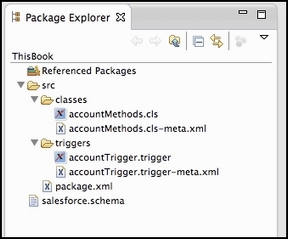Behind the scenes
If you're paying attention to the Package Explorer view in the Force.com IDE, you might have noticed that after creating our class, instead of one new file being created, there were two. The same thing happened after we created our trigger too, as shown in the following screenshot, which shows metadata files exist for each class and trigger:

You're not seeing double; these extra files are intentional and serve an important purpose. Remember back in Chapter 2, Apex Limits, when we looked at the metadata for our Apex code. These extra files store that metadata. In Apex classes, you can control the API version under which the code executes as well as the versions of any prebuilt packages that you might have installed. For triggers though, you have an added status attribute that you can use to turn off your trigger and prevent it from executing. This status attribute can be really useful if you need to perform a large data migration and don't want your trigger to execute. This...
























































